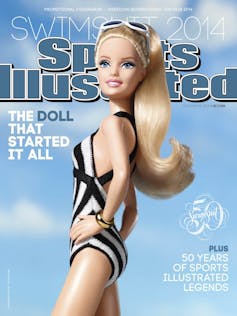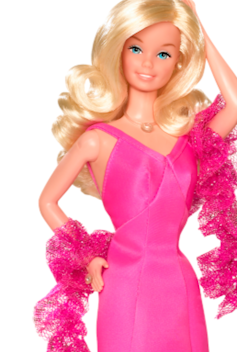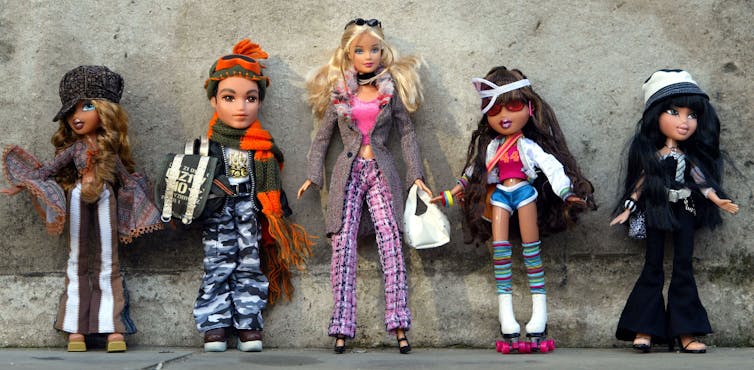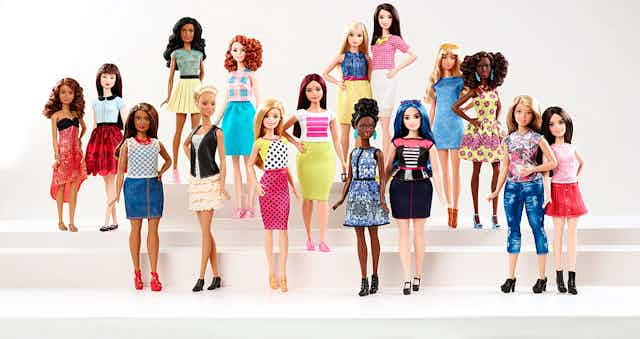Featured in a clear cut silhouette of her new plumper body option on the cover of Time Magazine on January 28, Barbie was declared to be the “American Beauty”, heralding an in-depth series of features on Mattel’s new design campaign of multiple Barbie body profiles and skin tones.
Time’s intense analysis is the latest chapter in three decades of Barbie’s popular and creative media crossovers into a knowing, adult culture, rather than the playground.
The dominant doll
In 1997 Lisa Jervis described Barbie in Mother Jones magazine as “one of the most popular women in America”. Barbie has been a high-profile cover girl before, for example on the iconic annual Swimsuit Issue of Sports Illustrated in 2014 (combining two perennial North American flashpoints of criticism around the objectification of women in contemporary public life).

While Barbie has featured frequently in intense debates around female body image and the inappropriate sexualisation of young girls, the doll has also documented and symbolised aspects of the female experience, changing fashions, changing career and educational expectations, a wide range of popular cultural and everyday aspects of female lives.
Barbie is a highly ubiquitous symbol of female identity, who has generated a uniquely live energy by mere longevity and tenacious presence within the public eye, and acquired an uncanny life beyond her plastic materialism .
Time addressed Barbie as both cultural phenomenon and business case study. Mattel’s global reach, cutting-edge marketing, early uptake of innovations in supply chain management and corporate dominance of toy-buying ensured it stayed in the public eye for half a century or more, buoyed up by the Barbie brand’s unparalleled dominance of the doll market.
Mattel particularly pioneered advertising tie-ins and sponsorship of children’s television content in the 1950s, and launched Barbie is a series of dreamy, yet formalised, evocations of high fashion and haute couture in television advertisements , proclaiming “Barbie you’re beautiful”.
Frequently flexible
Yet for a decade or more Mattel has become progressively less assured in how the doll is developed and presented, finally instituting a two-year-long review of Barbie’s image and her relevance to changing parameters of contemporary girlhood and new modes of parenting.
Her January 2016 changes of image and body type immediately engaged journalists around the world: Barbie has always provided good copy.
In her 1995 monograph Barbie’s Queer Accessories academic Erica Rand questioned whether this popularity was spontaneous, or due to Mattel’s assiduous and astute command of media practices.
The speedy uptake of the “new body” story reflected widespread excitement that Barbie was finally becoming part of the everyday world of imperfect women, who are not models or actresses and that now Barbie offered girls a realistic and recognisable image to identify with.
Yet for those who know Barbie’s half century and more of backstory, concerns about body type and ethnicity have impacted upon the doll for nearly two decades, overlooked in the general hype over the 2016 changes.

Mattel responded to some consumer criticism and remodelled her body as early as 1997 when Barbie’s breasts were reduced in size and her waist thickened. These changes had the effect of straightening her “drag queen” body, which was an inheritance from her German 1950s prototype Lilli: heavy shoulders, slim waist and hips, and those pneumatic, possibly artificial, breasts.
A flexible, slightly rubberised body with wire armature, used for DC comic heroine Barbies and cheerleaders around 2003, also featured broader female hips and smaller breasts, and presented a rather lithe, willowy profile.
A frequent alternative body used by Mattel from the late 1980s onwards for Barbie is a fully jointed, including ankles and wrists, “athletic” Barbie body that features flat feet not impractical heels.
Do the multiple new Barbie body types represent clever marketing rather than a move to a realistic image, given that clothes and shoes cannot be shared across differently sized dolls? Each doll must have her own set, in the manner that Lego designs packs of pieces that do not function outside the context story, or between other themes.

Previously, from 1959 to 1976, Mattel expected girls to have one or two dolls, but buy multiple outfits. Profit in the post-Superstar Barbie era (1977 onwards) has already been driven by the proliferation of different body formats and functions. A thoughtful, inclusive turn as seen in the 2016 new Barbie releases is a variant of this foundational trend.
Simultaneous but varied product has always been an essential part of the Barbie experience. Since 1977, Mattel has designed many novelty Barbie bodies that have different functions and capabilities, some surreal and highly artificial, including flying dolls, dancing dolls, dolls with bodies that light up with LEDs, dolls with mermaid tails instead of legs and even for a short period in 2009 highly controversial tattooed dolls.
Many Barbies are issued within the same year, with different pricepoints and levels of finishing and presentation to appeal to various age groups from pre-school age children to adult collectors. The 2016 new bodies merely extend Barbie’s already split identity.

From the mid-1960s Mattel always provided some options for alternative body and facial images to Barbie through her extended family and friends, who included Skipper and Francie, with different, less voluptuous, body types than Barbie. Midge, Barbie’s best friend, was originally a plain Madge Alsop character with freckles, as a handmaid to the diva’s greatness, but from about 1990 onwards she became an elegant, serene redhead.
While the 2016 line is praised for including multiracial options, there had been African American dolls in the Barbie family since Francie in 1966, followed by Barbie’s “friends” Christie, Brad and Cara in the 1960s and 1970s.
In 1981 Barbie herself became available as an African American doll, styled for her launch on Diana Ross in a red lurex evening gown.
The commodification of difference
Erika Nicole Kendall, writing in The Guardian, suggested that the new lines are not about greater sensitivity to consumers criticism but signs of an increasingly desperate development team:
Would Barbie be “diversifying” if it weren’t a last resort to save a dying brand?
Forbes magazine reported in 2014 that Elsa and Frozen toys outsold Barbie.
Barbie had already slipped behind the Bratz dolls in the British and Australian market by the early 2000s and in Australia Bratz dominated within a year of being launched.

Although faltering towards the end of the decade, not the least because of the weight of litigation with Mattel, Bratz showed up Barbie in the new millennium. Their mirroring of outrageous red carpet and rockstar fashion was both more faithful and convincing. The clothing featured better quality fabrics and more well made accessories than were sold with Barbie.
Overall, they captured the increasing importance of media celebrities in circulating and establishing styles, placing Barbie as a cautious follower rather than an innovator.
Most importantly Bratz were a non-hierarchical, multi-ethnic crew, who could not be defined by obvious visual stereotypes, due to their abstract, somewhat anime, styling, offering the dolls to multiple buyers and allowing for many different girls to identify with them.
Lisa Guerrero wrote in Can the Subaltern Shop? The Commodification of Difference in the Bratz:
They have presented a challenge to the Anglocentric version of womanhood found in the arena of toys that has been dominant since the 1959 introduction of Barbie. They have given face to difference and provided images through which young girls of colour might find themselves reflected.
Bratz’s runaway success made Mattel consciously explore alternative styling and address a greater cultural diversity, providing some of the most experimental dolls within the Mattel brand. My Scene dolls’ anime and slightly Japanese styling picked up on the detailed quality of the Bratz clothes and their multiracial social relations.
The Flavas were another answer to Bratz, both exotic and working class, with hip hop styling, a large range of skin tones and some particularly tough male imagery. They were intensely disliked in the United States.
Conservatives and fundamentalists saw them as criminal and delinquent personae inappropriate for child play. African Americans felt the Flava dolls were stereotyping their fashion choices and also imposing an underclass identity on the community.
Overseas in Britain and Europe the Flavas were seen as fascinating ambassadors for American cool.
On the opposite end of the fashion industry scale, the Barbie Basics lines were issued in annual sets from 2010-2014 to be dressed by collectors and amateur designers of doll couture.
In 2010, they included, in the female dolls, at least 12 different complexions, hair styles and body poses, with multi-ethnic Kens as well, all presented with avant garde, fashion forward personae.
Despite the global vote of media confidence, this forgotten back story suggests that The Guardian’s reading of the situation as desperation not innovation may well be right. Do Barbie’s multiple bodies welcome a new era of ethical body inclusiveness or do they shift deckchairs on the Titanic?

